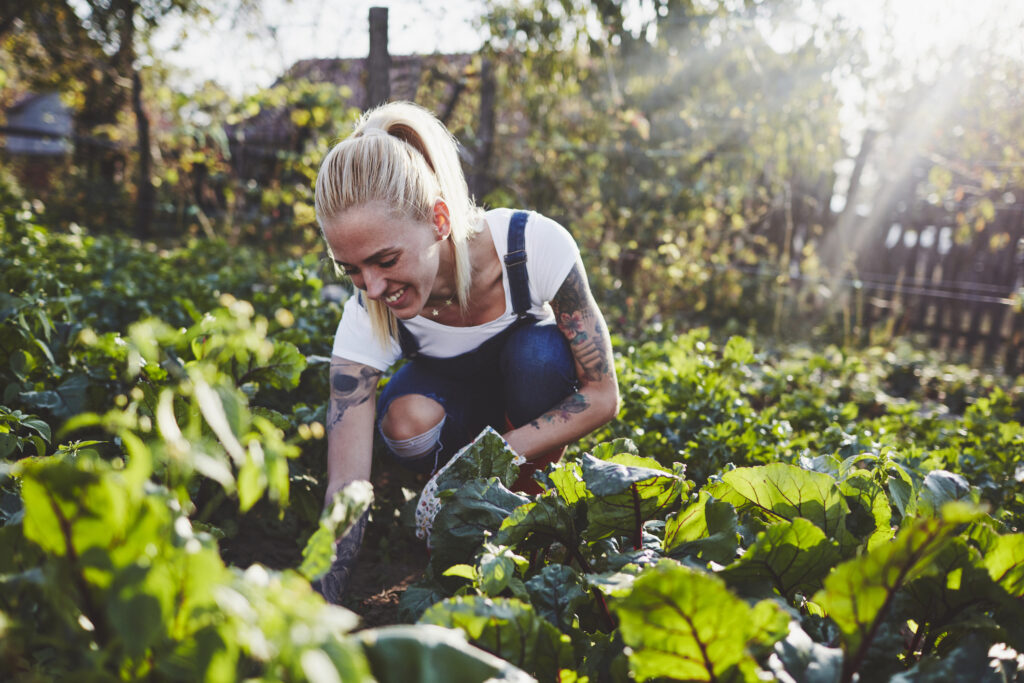
When planning our gardens, we often think of the tools we’ll need, like water nozzles, sprinklers, and hoses. Thankfully, Melnor® can help with that, but you will need to do more to grow strong, healthy plants.
This first step requires consideration for your soil. Don’t worry! Most don’t think of the soil when preparing for their spring and summer vegetable gardens. However, if your spinach or radishes aren’t ready for harvest after six weeks, the soil might be to blame. Plants, particularly vegetables that require more nutrients such as eggplant, pumpkins, and tomatoes, thrive in soils composed of highly variegated organic materials. Whether you are growing basketball-sized melons or delicate flowers, achieve optimal plant health by taking the necessary steps to prep your soil.
Thinking of growing vegetables this year? Catch our recent blog titled, “4 Early-Spring Vegetables Anyone Can Grow” if you want to learn how to grow spinach, brussels sprouts, radishes, and turnips!
Dirt vs. Soil. What Is The Difference?
Approximately half of your soil is made of eroded rock and minerals that have decomposed into smaller particles over thousands of years. The other half is organic matter, which forms from decayed foliage, old food, moss, bugs, and many other organisms.
Coexisting with that mixture are live bacteria, fungus, and microbes. These little guys help break down decaying plant material, deposit nitrogen into the soil, lift and loam soil, and do a slew of other vital things to the plants in your garden!
The difference between dirt and soil then is whether or not the soil includes live, organic materials. Dirt can easily be explained as “dead soil.” See below for examples:
Dead Soil:

Alive Soil:

What Soil Type Is Best?
Before we identify ways to prepare your soil, we need to recognize the differences in makeup.
Aside from organic materials, soil is composed of three different rock sizes. These rock sizes are categorized simply as large, medium, and small. If you are reading this, you might already have an idea of what kind of soil you have — sandy soil (large), silty soil (medium), or clay soil (small). If you don’t know, there is an easy test that will point you in the right direction. Go outside to your garden, grab a handful of soil with a wet hand, and look for these characteristics:
Sandy soil: This soil will feel rough due to the larger rock particles. This type of soil drains quickly and does not hold nutrients adequately.
Silty soil: This type of soil will feel smoother to the hand because of its medium-sized particles. When you grab this type of soil, it might feel a bit loose and crumbly. Silty soil holds more moisture and nutrients than sandy soil.
Clay soil: Tiny particles found in clay-based soil will feel sticky when saturated and spongy when damp. Clay soil tends to reach high temperatures in warmer months due to its slow absorption and draining qualities.
Thus, the perfect mix is soil that holds moisture well but drains so that your roots don’t become waterlogged. Most plants require oxygen to reach the roots for proper growth indicating a high priority for aeration. What do we call this soil?
Loamy soil: Good soil, as described above, crumbles when worked. It will not crack or crust over when dry, and it will not form a hard ball when squeezed. Gardeners should aim for these soil characteristics when growing their own plants.
What Does pH Have to Do With Soil?
The pH of your soil will also play a role depending on what specific type of nutrients (see figure 1 below) your plants will need. However, don’t let this stop you from experimenting in your garden, as even experienced gardeners ignore the pH of their soil.
Why? Unless you’re growing a plant that requires alkaline soil, such as lavender or foxgloves, or if your plants are struggling for unique reasons, it’s usually not necessary.
What If My Plants Are Struggling? A pH and general soil test will reveal your soil’s nutrition and mineral makeup which can be helpful for difficult plants. If you plan to grow prudent or fragile plants, you may want to consider this.
The ideal pH range where most organisms thrive is between 6.0 to 7.0. But most plants you come across at your local grocery store or on your morning stroll can tolerate a wide pH range.
Nutrient Availability Among Differing pH Levels

Figure 1. Image by CoolKoom/Wikimedia.
How Can I Improve My Soil?
At last, here we are! The following five steps are all easy ways to move forward with your garden plans — the right way. Vegetable garden or flower bed, these helpful tips will significantly improve your soil’s health and take you one step closer to the garden of your dreams.
1: Soil Aeration

This soil amending method requires no external tools. Just use your hands. Dig up, loosen, and equally disperse soil so that there are good airways for circulation. This small step can go a long way when it comes to plant maturation time.
The small critters that live in your soil naturally develop a porous structure that allows water and air to reach your plants’ roots. When you walk on it, especially when it’s moist, the gaps in your soil are compressed. By aerating your soil, you give those critters the room to roam and do their job in your garden. To avoid highly compacted soil, don’t work in the rain, don’t walk on your fresh soil, and prevent any additional disturbances like dogs digging up the worms in your soil.
2: Tilling

Take aeration a step further and till your ground. Till the soil as thoroughly as possible, at least 6 to 10 inches deep, using a spade or small shovel. By allowing vegetable roots to penetrate deeper, you can almost guarantee good plant health.
3. Add Organic Materials

Soil is a powerhouse for growing plants. But most don’t know that soil is made of multiple parts (reference Dirt vs. Soil section). To make sure your soil has enough of each part, you can start your own organic material collection bin.
Organic matter supplement options include:
Compost: Leaves, straw, and grass clippings are examples of this. Allow time for the material to decay by working it into the soil several weeks before planting.
Manure: Organic manure should be used and incorporated into the soil well before planting. Fresh manure should not be used since it might harm plants and bring illnesses. For every 100 square feet, apply 30 to 40 pounds of composted manure.
Food Materials: Banana clippings, half-eaten apples, and coffee grounds make up a small portion of superfoods teeming with nutrients that, when added to your soil, can foster healthy plant growth.
The most recommended application is 2-4 inches each year around springtime and closer to the last frost. You will want to give your organic matter time to set, especially if using manure. Recommended time-to-set is at least 4-6 weeks.
4. Add Mulch

When most think of mulch used in a garden, they think it’s for aesthetics and curb appeal. However, even as true as that is, mulch can also serve a dual purpose. When you add mulch over soil and around your plants, you protect them from wind, dehydration, and disturbance.
Remember, the perfect soil has a good mix of aeration, organic materials, and moisture retention. So, when you’re walking down your local hardware store looking for ways to boost your soil properties, you may find what you need in mulch. Your neighbors will also appreciate this.
5. Organize Rows

Uncommon for your average home gardener, but this maneuver can help in many ways. Particularly if you live in areas of high rainfall or poor/inconsistent weather conditions.
Rows help to promote air circulation, protect plants during high rainfall, encourage drainage, and help gardeners easily identify where they start seeds.
Depending on the size of your garden, you’ll want to make your rows 30-40 inches apart; some vegetables can be planted closer if space is a concern. Ensure your raised beds are 6-10 inches tall and 5-8 inches wide.
Conclusion
Gardening may seem anything but simple. That’s why we strive to provide information that can be effortlessly applied in your garden. After reading this blog, we hope you have a greater understanding of the types of soil, what soil is, and ways to improve it.
We hope that you use this blog as a toolkit when planning your new gardens this spring! We’d love to see your progress as well. Share images and posts with the hashtag #MelnorSoilPrep and there’s a chance we may see it or re-share it!
Sources
Masabnl, J. (2019, February 4). Soil preparation – how do you prepare soil for planting? Texas A&M AgriLife Extension Service. Retrieved January 26, 2022, from https://agrilifeextension.tamu.edu/library/gardening/soil-preparation/
Farmer’s Almanac, T. E. of. (2021, November 12). Soil preparation: How do you prepare garden soil for planting? Almanac.com. Retrieved January 26, 2022, from https://www.almanac.com/preparing-soil-planting#
Platt Hill Nursery, T. E. of. (2021, September 28). The Best Tips to Prepare Soil. Platt Hill Nursery. Retrieved January 26, 2022, from https://platthillnursery.com/best-tips-to-prepare-garden-soil/





